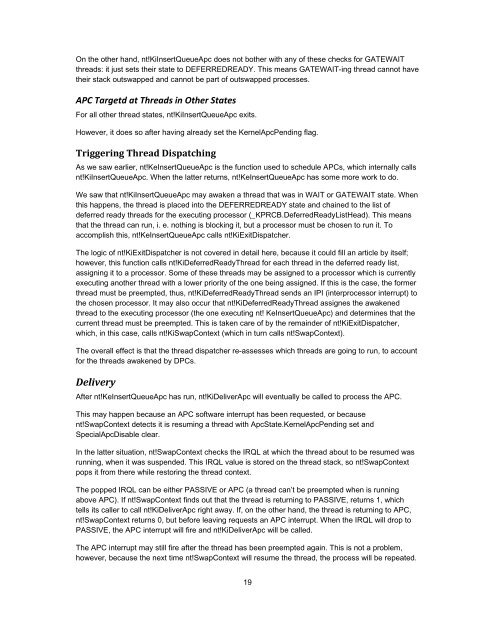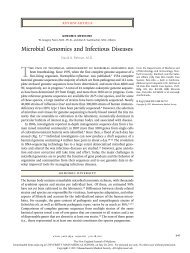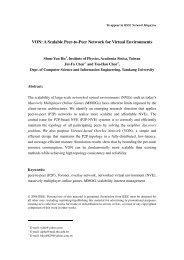366.7 KB - Evernote
366.7 KB - Evernote
366.7 KB - Evernote
Create successful ePaper yourself
Turn your PDF publications into a flip-book with our unique Google optimized e-Paper software.
On the other hand, nt!KiInsertQueueApc does not bother with any of these checks for GATEWAIT<br />
threads: it just sets their state to DEFERREDREADY. This means GATEWAIT-ing thread cannot have<br />
their stack outswapped and cannot be part of outswapped processes.<br />
APC Targetd at Threads in Other States<br />
For all other thread states, nt!KiInsertQueueApc exits.<br />
However, it does so after having already set the KernelApcPending flag.<br />
Triggering Thread Dispatching<br />
As we saw earlier, nt!KeInsertQueueApc is the function used to schedule APCs, which internally calls<br />
nt!KiInsertQueueApc. When the latter returns, nt!KeInsertQueueApc has some more work to do.<br />
We saw that nt!KiInsertQueueApc may awaken a thread that was in WAIT or GATEWAIT state. When<br />
this happens, the thread is placed into the DEFERREDREADY state and chained to the list of<br />
deferred ready threads for the executing processor (_KPRCB.DeferredReadyListHead). This means<br />
that the thread can run, i. e. nothing is blocking it, but a processor must be chosen to run it. To<br />
accomplish this, nt!KeInsertQueueApc calls nt!KiExitDispatcher.<br />
The logic of nt!KiExitDispatcher is not covered in detail here, because it could fill an article by itself;<br />
however, this function calls nt!KiDeferredReadyThread for each thread in the deferred ready list,<br />
assigning it to a processor. Some of these threads may be assigned to a processor which is currently<br />
executing another thread with a lower priority of the one being assigned. If this is the case, the former<br />
thread must be preempted, thus, nt!KiDeferredReadyThread sends an IPI (interprocessor interrupt) to<br />
the chosen processor. It may also occur that nt!KiDeferredReadyThread assignes the awakened<br />
thread to the executing processor (the one executing nt! KeInsertQueueApc) and determines that the<br />
current thread must be preempted. This is taken care of by the remainder of nt!KiExitDispatcher,<br />
which, in this case, calls nt!KiSwapContext (which in turn calls nt!SwapContext).<br />
The overall effect is that the thread dispatcher re-assesses which threads are going to run, to account<br />
for the threads awakened by DPCs.<br />
Delivery<br />
After nt!KeInsertQueueApc has run, nt!KiDeliverApc will eventually be called to process the APC.<br />
This may happen because an APC software interrupt has been requested, or because<br />
nt!SwapContext detects it is resuming a thread with ApcState.KernelApcPending set and<br />
SpecialApcDisable clear.<br />
In the latter situation, nt!SwapContext checks the IRQL at which the thread about to be resumed was<br />
running, when it was suspended. This IRQL value is stored on the thread stack, so nt!SwapContext<br />
pops it from there while restoring the thread context.<br />
The popped IRQL can be either PASSIVE or APC (a thread can’t be preempted when is running<br />
above APC). If nt!SwapContext finds out that the thread is returning to PASSIVE, returns 1, which<br />
tells its caller to call nt!KiDeliverApc right away. If, on the other hand, the thread is returning to APC,<br />
nt!SwapContext returns 0, but before leaving requests an APC interrupt. When the IRQL will drop to<br />
PASSIVE, the APC interrupt will fire and nt!KiDeliverApc will be called.<br />
The APC interrupt may still fire after the thread has been preempted again. This is not a problem,<br />
however, because the next time nt!SwapContext will resume the thread, the process will be repeated.<br />
19
















